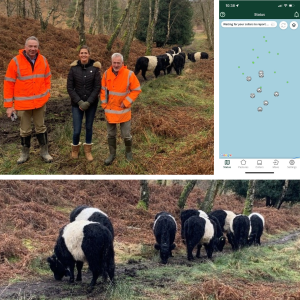Cemex has introduced Belted Galloways to land that we are looking after at our Rugeley site under our freehold obligations. The cattle have been introduced to help with grazing and specifically to help control the spread of bracken. This will allow heather to grow and flourish at this SSSI (Site of Special Scientific Interest) location, without the need to use chemical-based solutions to control the growth and spread of the bracken.
The land at Rugeley forms part of the Cannock Chase National Landscape (formerly an Area of Outstanding Natural Beauty), designated for its value as Lowland Heath, Parkland and Woodland. The work here is being carried out to manage the SSSI in favourable condition, and as part of Cemex’s wider environmental commitments to ensure the increase of biodiversity across its estate.
We are also trialling a new and innovative approach to managing the herd by using a digital software called, ‘No Fence,’ to assist with the management of the herd across such a vast site.
Each cow wears a small GPS collar, much like a traditional cattle bell around its neck, which then allows for the tracking of the cattle and helps to restrict the cattle to areas where grazing is required without the need for the building or maintenance of fences, which would be costly and in places challenging across a site of this size.
The Comms team went to the site to see how this works and to meet with Alex Finn (Restoration Manager for Aggregates), Alison Wise (Landscape Architect for Aggregates), Tony Thomas (our full-time external Landscape Manager) – our forestry and land restoration team and Jonelle Handford, a local grazier who looks after the cattle on a day-to-day basis. We asked Alex some questions about the project and how it came about.
How long have the cattle now been at the site and when were they first introduced?
Cattle were introduced in January this year. Initially eight were brought on we now have nine and as more are trained we will increase the size of the herd to 15 over the course of the next 12 months.
How did the opportunity to introduce the cattle to the site come about?
We knew about the collars but have never had a site where we could practically use them. The other problem has been finding a local grazier close to our sites who uses the collars as the cattle have to be trained. We came across Jonelle (a local cattle grazier) and as she is local to the site we were particularly interested in asking her to join the project.
What are the benefits of this unique project?
There are considerable benefits in using the cattle for grazing management. The main one is not having to fence 90 hectares of land which as you could imagine would be costly. Fencing is also a problem from vandalism as we have found on other sites. The cattle also cut cost on using herbicides to control unwanted vegetation to promote heather growth which is one of the main objectives of the heathland management.
Other benefits are the helping to reduce unwanted trespass, particularly 4×4 which are damaging to the heathland.
